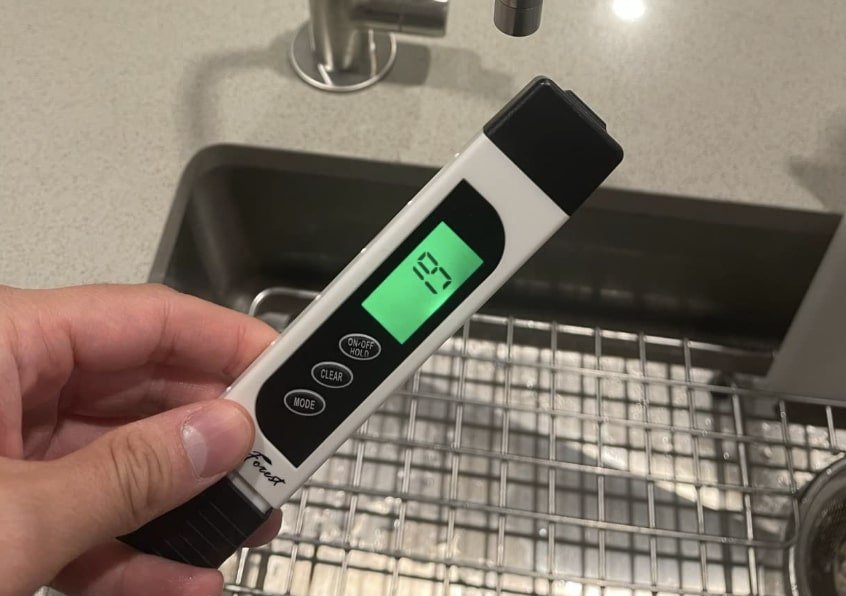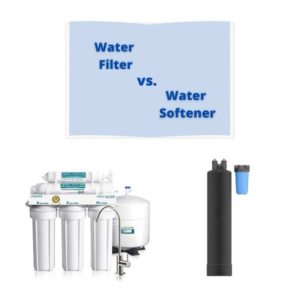How Reverse Osmosis Filters Your Water?
Reverse osmosis uses pressure to reverse the natural flow of source water forcing pure water molecules to pass through a semi-permeable membrane. All impurities are left on the other side of the membrane forming what is called brine or reject which is then discarded by the system.
One of the main benefits of RO systems is that they are effective at removing impurities like chlorine, lead, arsenic, and other heavy metals from your drinking supply. Additionally, these filters eliminate bacteria and viruses from your tap water as well as any unpleasant tastes or odors. In addition to filtering out harmful substances, reverse osmosis can also reduce alkaline levels in hard water which may be beneficial for those who have sensitive skin or allergies.

Contaminants that Reverse Osmosis Removes and Reduces
Water contaminants can be a major issue for drinking water, but reverse osmosis systems can help eliminate these contaminants and reduce the risk of adverse health effects. RO systems remove the following contaminants from the drinking water:
Harmful Bacteria, Viruses, and Protozoa
Reverse osmosis can remove harmful bacteria, viruses, and protozoa from drinking water. Common harmful pathogens in water are E-coli bacteria, rotavirus, and Giardia Lamblia protozoa can cause mild to serious symptoms.
Since these microorganisms are considered impurities in water, the RO membrane will not allow them to pass through. It’s also worth mentioning that RO membranes have micropore sizes of 0.0001 microns which is too small for these biological hazards to penetrate.
Heavy Metals
Reverse osmosis filters can also remove heavy metals from water, such as arsenic, cobalt, lead, and mercury that are often detected in your tap water. Heavy metal toxicity can compromise the normal functioning of the important organs of the body like the brain, lungs, liver, and kidney.
Specifically, lead should not be present even at low levels in your drinking water. In fact, the maximum contaminant level (MCL) set by EPA for lead in drinking water is zero. This heavy metal has no known benefits to the human body and is very harmful to someone exposed to it. Thankfully, reverse osmosis systems have the ability to remove 99% of lead from water.

Trace Minerals
A reverse osmosis system can also remove over 99% of trace minerals from water. Trace minerals are small amounts of essential elements such as zinc, copper, iron, and magnesium which can be beneficial for health when consumed in moderation. While these are good for you in small doses, large amounts of these minerals can lead to health problems over time.
Organic Contaminants
Volatile organic chemicals (VOCs) which are released as dangerous gases are often found in petroleum products, paint, aerosol sprays, and body care items. Benzene, ethanol, toluene, acetone, and formaldehyde are some of the many VOCs that can reach water supplies when products containing them are improperly disposed of.
Reverse osmosis alone cannot get rid of VOCs.However, RO systems have prefilters that include a carbon block filter that can effectively remove chlorine and VOCs before the water flows to the RO membrane.
Pesticide Contaminants
Many pesticide ingredients such as atrazine, cyanazine, and prometon diazinon are detected in seawater and groundwater. When it comes to removing these chemicals in water, RO systems incorporated with carbon block filters are effective.
Molecules better adhere on the surface of the carbon block filters where they experience more inward force. This process is also known as adsorption. For this reason, most RO systems come with carbon filters to remove these dangerous substances.
Pharmaceuticals
Reverse osmosis systems are regarded as one of the most reliable means for removing contaminants from water, including pharmaceuticals. This is due to their efficient use of membrane filtration that can effectively remove particles larger than 0.0001 microns in size from the water supply.
TDS Level
Total Dissolved Solids refers to the number of dissolved substances in the water which includes minerals, organic salts, and some organic matter. Due to the possibility of high organic salts and toxic substances, it is not advisable to consume water with high TDS levels. However, eliminating all these substances could also result in tasteless water.
To preserve the palatability of water, EPA has set the maximum concentration level for TDS levels to 500 mg/L. Most RO systems can remove TDS by 90-95%. So, if your water’s TDS level is 1000 mg/L, then after filtering it with an RO system, you’ll get a TDS level of around 100-50mg/L.
If you are used to the taste of mineral water, you might find RO water a bit flat. Consider remineralizing your RO water to bring back the healthy minerals removed during the process.

Safety Concerns on Reverse Osmosis Water
Reverse osmosis water systems are growing in popularity as a method for producing clean drinking water. But is water purified by reverse osmosis safe or is it healthy? There are some potential safety concerns that should be addressed before installing one of these systems in your home or business.
- Reverse osmosis can also reduce certain minerals from the water supply which are essential for good health. For example, calcium and magnesium have been removed from drinking water through reverse osmosis systems as they are filtered out as contaminants. This could potentially cause mineral deficiencies if not supplemented properly in other ways.
- Another safety concern is the potential growth of Heterotrophic bacteria within the reverse osmosis tank. They can grow and thrive as they consume organic carbon as food. At low counts, they are not harmful and are even helpful in maintaining your RO system. However, a high bacterial count could indicate a breeding ground for more harmful microorganisms such as E.coli or Legionella.
Is reverse osmosis water acidic?
RO systems use a process called reverse osmosis to filter out impurities and contaminants from regular tap water, leaving behind clean drinking water. The question arises, however, if the process affects the pH or acidity level of the treated water.
The answer is yes; reverse osmosis does reduce the pH levels in drinking water. RO systems are designed to remove certain minerals, including calcium and magnesium, which can increase the alkalinity or pH level of your drinking water. Without these minerals present, the resulting treated drinking water will be slightly acidic with a lower pH level than untreated tap water.
Does drinking RO water cause health problems?
RO water, or reverse osmosis water, is a type of purified drinking water that has been filtered to remove impurities like bacteria, viruses, heavy metals, and chlorine. Drinking water produced by RO systems is generally considered safe for consumption and there are no scientific studies that link RO water to health problems.
The only exception is if you have conditions like acid reflux that can worsen by consuming acidic beverages. However, remineralizing your RO water could increase alkalinity, making it safer to drink.
Conclusion
So is water purified by reverse osmosis safe? Reverse osmosis filtration systems are an effective way to purify water. They help to remove contaminants from the water, making it safe for consumption. However, there are some safety concerns with RO systems, such as the elimination of helpful minerals, but these can be addressed by installing a remineralization filter.
Overall, when installed and maintained properly, RO systems provide clean and safe drinking water. RO water is also more cost-effective than bottled water. It’s important to remember that monitoring your water supply is essential for long-term good health.

